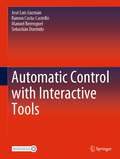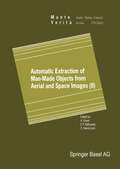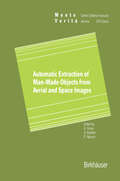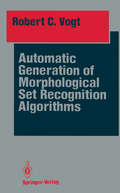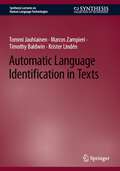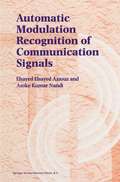- Table View
- List View
Automatic Control with Interactive Tools
by José Luis Guzmán Ramon Costa-Castelló Manuel Berenguel Sebastián DormidoAutomatic Control with Interactive Tools is a textbook for undergraduate study of automatic control. Providing a clear course structure, and covering concepts taught in engineering degrees, this book is an ideal companion to those studying or teaching automatic control. The authors have used this text successfully to teach their students.By providing unique interactive tools, which have been designed to illustrate the most important automatic control concepts, Automatic Control with Interactive Tools helps students overcome the potential barriers presented by the significant mathematical content of automatic control courses. Even when they have previously had only the benefit of an introductory control course, the software tools presented will help readers to get to grips with the use of such techniques as differential equations, linear algebra, and differential geometry. This textbook covers the breadth of automatic control topics, including time responses of dynamic systems, the Nyquist criterion and PID control. It switches smoothly between analytical and practical approaches. Automatic Control with Interactive Tools offers a clear introduction to automatic control, ideal for undergraduate students, instructors and anyone wishing to familiarize themselves with the fundamentals of the subject
Automatic Defense Against Zero-day Polymorphic Worms in Communication Networks
by Mohssen Mohammed Al-Sakib Khan PathanAble to propagate quickly and change their payload with each infection, polymorphic worms have been able to evade even the most advanced intrusion detection systems (IDS). And, because zero-day worms require only seconds to launch flooding attacks on your servers, using traditional methods such as manually creating and storing signatures to de
Automatic Defense Against Zero-day Polymorphic Worms in Communication Networks
by Mohssen Mohammed Al-Sakib Khan PathanAble to propagate quickly and change their payload with each infection, polymorphic worms have been able to evade even the most advanced intrusion detection systems (IDS). And, because zero-day worms require only seconds to launch flooding attacks on your servers, using traditional methods such as manually creating and storing signatures to de
Automatic Design of Decision-Tree Induction Algorithms (SpringerBriefs in Computer Science)
by Rodrigo C. Barros André C.P.L.F de Carvalho Alex A. FreitasPresents a detailed study of the major design components that constitute a top-down decision-tree induction algorithm, including aspects such as split criteria, stopping criteria, pruning and the approaches for dealing with missing values. Whereas the strategy still employed nowadays is to use a 'generic' decision-tree induction algorithm regardless of the data, the authors argue on the benefits that a bias-fitting strategy could bring to decision-tree induction, in which the ultimate goal is the automatic generation of a decision-tree induction algorithm tailored to the application domain of interest. For such, they discuss how one can effectively discover the most suitable set of components of decision-tree induction algorithms to deal with a wide variety of applications through the paradigm of evolutionary computation, following the emergence of a novel field called hyper-heuristics."Automatic Design of Decision-Tree Induction Algorithms" would be highly useful for machine learning and evolutionary computation students and researchers alike.
Automatic Detection of Verbal Deception (Synthesis Lectures on Human Language Technologies)
by Eileen Fitzpatrick Joan Bachenko Tommaso FornaciariThe attempt to spot deception through its correlates in human behavior has a long history. Until recently, these efforts have concentrated on identifying individual "cues" that might occur with deception. However, with the advent of computational means to analyze language and other human behavior, we now have the ability to determine whether there are consistent clusters of differences in behavior that might be associated with a false statement as opposed to a true one. While its focus is on verbal behavior, this book describes a range of behaviors—physiological, gestural as well as verbal—that have been proposed as indicators of deception. An overview of the primary psychological and cognitive theories that have been offered as explanations of deceptive behaviors gives context for the description of specific behaviors. The book also addresses the differences between data collected in a laboratory and "real-world" data with respect to the emotional and cognitive state of the liar. It discusses sources of real-world data and problematic issues in its collection and identifies the primary areas in which applied studies based on real-world data are critical, including police, security, border crossing, customs, and asylum interviews; congressional hearings; financial reporting; legal depositions; human resource evaluation; predatory communications that include Internet scams, identity theft, and fraud; and false product reviews. Having established the background, this book concentrates on computational analyses of deceptive verbal behavior that have enabled the field of deception studies to move from individual cues to overall differences in behavior. The computational work is organized around the features used for classification from ����-gram through syntax to predicate-argument and rhetorical structure. The book concludes with a set of open questions that the computational work has generated.
Automatic Differentiation: (pdf) (Lecture Notes in Computational Science and Engineering #50)
by H. Martin Bücker George Corliss Paul Hovland Uwe Naumann Boyana NorrisAutomatic Differentiation of Algorithms: From Simulation to Optimization
by George Corliss Christele Faure Andreas Griewank Laurent Hascoet Uwe NaumannA survey book focusing on the key relationships and synergies between automatic differentiation (AD) tools and other software tools, such as compilers and parallelizers, as well as their applications. The key objective is to survey the field and present the recent developments. In doing so the topics covered shed light on a variety of perspectives. They reflect the mathematical aspects, such as the differentiation of iterative processes, and the analysis of nonsmooth code. They cover the scientific programming aspects, such as the use of adjoints in optimization and the propagation of rounding errors. They also cover "implementation" problems.
Automatic Digital Document Processing and Management: Problems, Algorithms and Techniques (Advances in Computer Vision and Pattern Recognition)
by Stefano FerilliThis text reviews the issues involved in handling and processing digital documents. Examining the full range of a document’s lifetime, the book covers acquisition, representation, security, pre-processing, layout analysis, understanding, analysis of single components, information extraction, filing, indexing and retrieval. Features: provides a list of acronyms and a glossary of technical terms; contains appendices covering key concepts in machine learning, and providing a case study on building an intelligent system for digital document and library management; discusses issues of security, and legal aspects of digital documents; examines core issues of document image analysis, and image processing techniques of particular relevance to digitized documents; reviews the resources available for natural language processing, in addition to techniques of linguistic analysis for content handling; investigates methods for extracting and retrieving data/information from a document.
Automatic Disambiguation of Author Names in Bibliographic Repositories (Synthesis Lectures on Information Concepts, Retrieval, and Services)
by Anderson A. Ferreira Marcos André Gonçalves Alberto H. LaenderThis book deals with a hard problem that is inherent to human language: ambiguity. In particular, we focus on author name ambiguity, a type of ambiguity that exists in digital bibliographic repositories, which occurs when an author publishes works under distinct names or distinct authors publish works under similar names. This problem may be caused by a number of reasons, including the lack of standards and common practices, and the decentralized generation of bibliographic content. As a consequence, the quality of the main services of digital bibliographic repositories such as search, browsing, and recommendation may be severely affected by author name ambiguity. The focal point of the book is on automatic methods, since manual solutions do not scale to the size of the current repositories or the speed in which they are updated. Accordingly, we provide an ample view on the problem of automatic disambiguation of author names, summarizing the results of more than a decade of research on this topic conducted by our group, which were reported in more than a dozen publications that received over 900 citations so far, according to Google Scholar. We start by discussing its motivational issues (Chapter 1). Next, we formally define the author name disambiguation task (Chapter 2) and use this formalization to provide a brief, taxonomically organized, overview of the literature on the topic (Chapter 3). We then organize, summarize and integrate the efforts of our own group on developing solutions for the problem that have historically produced state-of-the-art (by the time of their proposals) results in terms of the quality of the disambiguation results. Thus, Chapter 4 covers HHC - Heuristic-based Clustering, an author name disambiguation method that is based on two specific real-world assumptions regarding scientific authorship. Then, Chapter 5 describes SAND - Self-training Author Name Disambiguator and Chapter 6 presents two incremental author name disambiguation methods, namely INDi - Incremental Unsupervised Name Disambiguation and INC- Incremental Nearest Cluster. Finally, Chapter 7 provides an overview of recent author name disambiguation methods that address new specific approaches such as graph-based representations, alternative predefined similarity functions, visualization facilities and approaches based on artificial neural networks. The chapters are followed by three appendices that cover, respectively: (i) a pattern matching function for comparing proper names and used by some of the methods addressed in this book; (ii) a tool for generating synthetic collections of citation records for distinct experimental tasks; and (iii) a number of datasets commonly used to evaluate author name disambiguation methods. In summary, the book organizes a large body of knowledge and work in the area of author name disambiguation in the last decade, hoping to consolidate a solid basis for future developments in the field.
Automatic Extraction of Man-Made Objects from Aerial and Space Images (Monte Verita)
by Armin Gruen E. P. Baltsavias O. HenricssonAdvancements in digital sensor technology, digital image analysis techniques, as well as computer software and hardware have brought together the fields of computer vision and photogrammetry, which are now converging towards sharing, to a great extent, objectives and algorithms. The potential for mutual benefits by the close collaboration and interaction of these two disciplines is great, as photogrammetric know-how can be aided by the most recent image analysis developments in computer vision, while modern quantitative photogrammetric approaches can support computer vision activities. Devising methodologies for automating the extraction of man-made objects (e.g. buildings, roads) from digital aerial or satellite imagery is an application where this cooperation and mutual support is already reaping benefits. The valuable spatial information collected using these interdisciplinary techniques is of improved qualitative and quantitative accuracy. This book offers a comprehensive selection of high-quality and in-depth contributions from world-wide leading research institutions, treating theoretical as well as implementational issues, and representing the state-of-the-art on this subject among the photogrammetric and computer vision communities.
Automatic Extraction of Man-Made Objects from Aerial Space Images (Monte Verita)
by Armin Gruen Olaf Kuebler Peggy AgourisAdvancements in digital sensor technology, digital image analysis techniques, as well as computer software and hardware have brought together the fields of computer vision and photogrammetry, which are now converging towards sharing, to a great extent, objectives and algorithms. The potential for mutual benefits by the close collaboration and interaction of these two disciplines is great, as photogrammetric know-how can be aided by the most recent image analysis developments in computer vision, while modern quantitative photogrammetric approaches can support computer vision activities. Devising methodologies for automating the extraction of man-made objects (e.g. buildings, roads) from digital aerial or satellite imagery is an application where this cooperation and mutual support is already reaping benefits. The valuable spatial information collected using these interdisciplinary techniques is of improved qualitative and quantitative accuracy. This book offers a comprehensive selection of high-quality and in-depth contributions from world-wide leading research institutions, treating theoretical as well as implementational issues, and representing the state-of-the-art on this subject among the photogrammetric and computer vision communities.
Automatic Fingerprint Recognition Systems
by Nalini Ratha Ruud BolleAn authoritative survey of intelligent fingerprint-recognition concepts, technology, and systems is given. Editors and contributors are the leading researchers and applied R&D developers of this personal identification (biometric security) topic and technology. Biometrics and pattern recognition researchers and professionals will find the book an indispensable resource for current knowledge and technology in the field.
Automatic Generation of Combinatorial Test Data (SpringerBriefs in Computer Science)
by Jian Zhang Zhiqiang Zhang Feifei MaThis book reviews the state-of-the-art in combinatorial testing, with particular emphasis on the automatic generation of test data. It describes the most commonly used approaches in this area - including algebraic construction, greedy methods, evolutionary computation, constraint solving and optimization - and explains major algorithms with examples. In addition, the book lists a number of test generation tools, as well as benchmarks and applications. Addressing a multidisciplinary topic, it will be of particular interest to researchers and professionals in the areas of software testing, combinatorics, constraint solving and evolutionary computation.
Automatic Generation of Computer Animation: Using AI for Movie Animation (Lecture Notes in Computer Science #2160)
by Ruqian Lu Songmao ZhangWe are both fans of watching animated stories. Every evening, before or after d- ner, we always sit in front of the television and watch the animation program, which is originally produced and shown for children. We find ourselves becoming younger while immerged in the interesting plot of the animation: how the princess is first killed and then rescued, how the little rat defeats the big cat, etc. But what we have found in those animation programs are not only interesting plots, but also a big chance for the application of computer science and artificial intelligence techniques. As is well known, the cost of producing animated movies is very high, even with the use of computer graphics techniques. Turning a story in text form into an animated movie is a long and complicated procedure. We came to the c- clusion that many parts of this process could be automated by using artificial - telligence techniques. It is actually a challenge and test for machine intelligence. So we decided to explore the possibility of a full life cycle automation of c- puter animation generation. By full life cycle we mean the generation process of computer animation from a children s story in natural language text form to the final animated movie. It is of course a task of immense difficulty. However, we decided to try our best and to see how far we could go.
Automatic Generation of Morphological Set Recognition Algorithms (Springer Series in Perception Engineering)
by Robert C. VogtSince the early days of computers, machine learning and automatic programming have attracted researchers in computer science and related fields, particularly pattern recognition and automatic control theory. Most of the learning concepts in machine perception have been inspired by pattern recognition approaches that rely on statistical techniques. These statistical techniques have applicability in limited recognition tasks. Automatic programming in perception systems has generally been limited to interfaces that allow easy specification of the task using natural language. Clearly, machine learning and automatic programming can make percep tion systems powerful and easy to use. Vogt's book addresses both these tasks in the context of machine vision. He uses morphological operations to implement his approach which was developed for solving the figure-ground problem in images. His system selects the correct se quence of operators to accept or reject pixels for fmding objects in an image. The sequence of operators is selected after a user specifies what the correct objects are. On the surface it may appear that the problem solved by the system is not very interesting, however, the contribution ofVogt' s work should not be judged by the images that the system can segment. Its real contribution is in demonstrat ing, possibly for'the frrst time, that automatic programming is possible in computer vision systems. The selection of morphological operators demonstrates that to implement an automatic programming-based approach, operators whose behavior is clearly defined in the image space are required.
Automatic Indexing and Abstracting of Document Texts (The Information Retrieval Series #6)
by Marie-Francine MoensAutomatic Indexing and Abstracting of Document Texts summarizes the latest techniques of automatic indexing and abstracting, and the results of their application. It also places the techniques in the context of the study of text, manual indexing and abstracting, and the use of the indexing descriptions and abstracts in systems that select documents or information from large collections. Important sections of the book consider the development of new techniques for indexing and abstracting. The techniques involve the following: using text grammars, learning of the themes of the texts including the identification of representative sentences or paragraphs by means of adequate cluster algorithms, and learning of classification patterns of texts. In addition, the book is an attempt to illuminate new avenues for future research. Automatic Indexing and Abstracting of Document Texts is an excellent reference for researchers and professionals working in the field of content management and information retrieval.
Automatic Language Identification in Texts (Synthesis Lectures on Human Language Technologies)
by Tommi Jauhiainen Marcos Zampieri Timothy Baldwin Krister LindénThis book provides readers with a brief account of the history of Language Identification (LI) research and a survey of the features and methods most used in LI literature. LI is the problem of determining the language in which a document is written and is a crucial part of many text processing pipelines. The authors use a unified notation to clarify the relationships between common LI methods. The book introduces LI performance evaluation methods and takes a detailed look at LI-related shared tasks. The authors identify open issues and discuss the applications of LI and related tasks and proposes future directions for research in LI.
Automatic Layout Modification: Including design reuse of the Alpha CPU in 0.13 micron SOI technology
by Michael ReinhardtThis volume is a welcome effort towards improving some of the practices in chip design today. The authors provide a comprehensive reference work on Automatic Layout Modification which will be valuable to VLSI courses at universities, and to CAD and circuit engineers and engineering managers.
Automatic Learning Techniques in Power Systems (Power Electronics and Power Systems)
by Louis A. WehenkelAutomatic learning is a complex, multidisciplinary field of research and development, involving theoretical and applied methods from statistics, computer science, artificial intelligence, biology and psychology. Its applications to engineering problems, such as those encountered in electrical power systems, are therefore challenging, while extremely promising. More and more data have become available, collected from the field by systematic archiving, or generated through computer-based simulation. To handle this explosion of data, automatic learning can be used to provide systematic approaches, without which the increasing data amounts and computer power would be of little use. Automatic Learning Techniques in Power Systems is dedicated to the practical application of automatic learning to power systems. Power systems to which automatic learning can be applied are screened and the complementary aspects of automatic learning, with respect to analytical methods and numerical simulation, are investigated. This book presents a representative subset of automatic learning methods - basic and more sophisticated ones - available from statistics (both classical and modern), and from artificial intelligence (both hard and soft computing). The text also discusses appropriate methodologies for combining these methods to make the best use of available data in the context of real-life problems. Automatic Learning Techniques in Power Systems is a useful reference source for professionals and researchers developing automatic learning systems in the electrical power field.
Automatic Malware Analysis: An Emulator Based Approach (SpringerBriefs in Computer Science)
by Heng Yin Dawn SongMalicious software (i.e., malware) has become a severe threat to interconnected computer systems for decades and has caused billions of dollars damages each year. A large volume of new malware samples are discovered daily. Even worse, malware is rapidly evolving becoming more sophisticated and evasive to strike against current malware analysis and defense systems. Automatic Malware Analysis presents a virtualized malware analysis framework that addresses common challenges in malware analysis. In regards to this new analysis framework, a series of analysis techniques for automatic malware analysis is developed. These techniques capture intrinsic characteristics of malware, and are well suited for dealing with new malware samples and attack mechanisms.
Automatic Methods for the Refinement of System Models: From the Specification to the Implementation (SpringerBriefs in Electrical and Computer Engineering)
by Julia Seiter Robert Wille Rolf DrechslerThis book provides a comprehensive overview of automatic model refinement, which helps readers close the gap between initial textual specification and its desired implementation. The authors enable readers to follow two “directions” for refinement: Vertical refinement, for adding detail and precision to single description for a given model and Horizontal refinement, which considers several views on one level of abstraction, refining the system specification by dedicated descriptions for structure or behavior. The discussion includes several methods which support designers of electronic systems in this refinement process, including verification methods to check automatically whether a refinement has been conducted as intended.
Automatic Modulation Recognition of Communication Signals
by Elsayed Azzouz A.K. NandiAutomatic modulation recognition is a rapidly evolving area of signal analysis. In recent years, interest from the academic and military research institutes has focused around the research and development of modulation recognition algorithms. Any communication intelligence (COMINT) system comprises three main blocks: receiver front-end, modulation recogniser and output stage. Considerable work has been done in the area of receiver front-ends. The work at the output stage is concerned with information extraction, recording and exploitation and begins with signal demodulation, that requires accurate knowledge about the signal modulation type. There are, however, two main reasons for knowing the current modulation type of a signal; to preserve the signal information content and to decide upon the suitable counter action, such as jamming. Automatic Modulation Recognition of Communications Signals describes in depth this modulation recognition process. Drawing on several years of research, the authors provide a critical review of automatic modulation recognition. This includes techniques for recognising digitally modulated signals. The book also gives comprehensive treatment of using artificial neural networks for recognising modulation types. Automatic Modulation Recognition of Communications Signals is the first comprehensive book on automatic modulation recognition. It is essential reading for researchers and practising engineers in the field. It is also a valuable text for an advanced course on the subject.
Automatic Nonuniform Random Variate Generation (Statistics and Computing)
by Wolfgang Hörmann Josef Leydold Gerhard DerflingerThe recent concept of universal (also called automatic or black-box) random variate generation can only be found dispersed in the literature. Being unique in its overall organization, the book covers not only the mathematical and statistical theory but also deals with the implementation of such methods. All algorithms introduced in the book are designed for practical use in simulation and have been coded and made available by the authors. Examples of possible applications of the presented algorithms (including option pricing, VaR and Bayesian statistics) are presented at the end of the book.
Automatic Parallelization: New Approaches to Code Generation, Data Distribution, and Performance Prediction
by Christoph W. KesslerDistributed-memory multiprocessing systems (DMS), such as Intel's hypercubes, the Paragon, Thinking Machine's CM-5, and the Meiko Computing Surface, have rapidly gained user acceptance and promise to deliver the computing power required to solve the grand challenge problems of Science and Engineering. These machines are relatively inexpensive to build, and are potentially scalable to large numbers of processors. However, they are difficult to program: the non-uniformity of the memory which makes local accesses much faster than the transfer of non-local data via message-passing operations implies that the locality of algorithms must be exploited in order to achieve acceptable performance. The management of data, with the twin goals of both spreading the computational workload and minimizing the delays caused when a processor has to wait for non-local data, becomes of paramount importance. When a code is parallelized by hand, the programmer must distribute the program's work and data to the processors which will execute it. One of the common approaches to do so makes use of the regularity of most numerical computations. This is the so-called Single Program Multiple Data (SPMD) or data parallel model of computation. With this method, the data arrays in the original program are each distributed to the processors, establishing an ownership relation, and computations defining a data item are performed by the processors owning the data.
Automatic Parallelization: An Overview of Fundamental Compiler Techniques (Synthesis Lectures on Computer Architecture)
by Samuel MidkiffCompiling for parallelism is a longstanding topic of compiler research. This book describes the fundamental principles of compiling "regular" numerical programs for parallelism. We begin with an explanation of analyses that allow a compiler to understand the interaction of data reads and writes in different statements and loop iterations during program execution. These analyses include dependence analysis, use-def analysis and pointer analysis. Next, we describe how the results of these analyses are used to enable transformations that make loops more amenable to parallelization, and discuss transformations that expose parallelism to target shared memory multicore and vector processors. We then discuss some problems that arise when parallelizing programs for execution on distributed memory machines. Finally, we conclude with an overview of solving Diophantine equations and suggestions for further readings in the topics of this book to enable the interested reader to delve deeper into the field. Table of Contents: Introduction and overview / Dependence analysis, dependence graphs and alias analysis / Program parallelization / Transformations to modify and eliminate dependences / Transformation of iterative and recursive constructs / Compiling for distributed memory machines / Solving Diophantine equations / A guide to further reading
